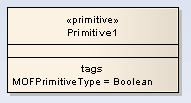
A Primitive element identifies a predefined data type, without any relevant substructure (i.e. it has no parts in the context of UML).
Toolbox Icon
![]()
OMG UML Specification
The OMG UML specification (UML Superstructure Specification, v2.1.1, p. 122) states:
"A primitive data type can have an algebra and operations defined outside of UML, for example, mathematically ... The run-time instances of a primitive type are data values. The values are in many-to-one correspondence to mathematical elements defined outside of UML (for example, the various integers). Instances of primitive types do not have identity. If two instances have the same representation, then they are indistinguishable."
Primitive for MOF Diagrams
Drag and drop a Primitive element from the Metamodel Elements page of the Enterprise Architect UML Toolbox; the following dialog displays.

Enter the Primitive name and type, and any notes required. The following Types are available, as defined in the MOF specification.



